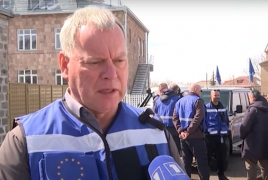
For more than 10 days, observers of the European Union mission in Armenia have been conducting patrols along the border with Azerbaijan, including the border with Nakhichevan.
Once a week, the mission sends reports to Brussels, which in turn determines whether or not to publish them.
According to Dr. Markus Ritter, who is the head of the EU monitoring mission in Armenia, the observers show with their presence that the international community is here to protect the local people.
Ritter is a senior police officer from Germany, who has been to South Sudan, Kosovo, Afghanistan, Georgia and will spend the next 2 years in Armenia.
The chief observer noted that the EU mission has three objectives in Armenia.
“The first is to patrol the border with Azerbaijan, including the border with Nakhichevan, and report on everything. The second is to ensure people's safety through patrolling, and that means visiting villages, border areas, showing people that we are here and our task is to take care of them. And the third is the introduction of trust-building mechanisms, but that is already a matter for the future. Now the priority is to monitor the situation along the border,” Ritter said.
Although the mission has started its work, not all members have arrived in Armenia yet. At the moment, there are about 50 monitors, the rest will arrive in March and April. The mission consists of members from 25 EU member states: France, Germany, Portugal, Poland, Sweden and other countries.
In February, the European Union launched a civilian mission in Armenia, which is tasked to promote settlement of the situation with Azerbaijan. The mission’s two-year mandate envisages patrolling and reporting about the situation to Brussels to raise its awareness of the situation on the ground. According to experts in Brussels, the mission is ultimately geared to enhance the European Union’s influence in the South Caucasus amid its confrontation with Russia.

